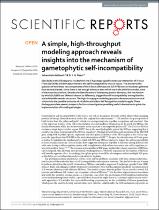| dc.contributor.author | Ashkani, Jahanshah | |
| dc.contributor.author | Rees, D. J. G. | |
| dc.date.accessioned | 2023-06-05T10:32:51Z | |
| dc.date.available | 2023-06-05T10:32:51Z | |
| dc.date.issued | 2016 | |
| dc.identifier.citation | Ashkani, J., & Rees, D. J. G. (2016). A simple, high-throughput modeling approach reveals insights into the mechanism of gametophytic self-incompatibility. Scientific Reports, 6, 34732. https://doi.org/10.1038/srep34732 | en_US |
| dc.identifier.issn | 2045-2322 | |
| dc.identifier.uri | http://hdl.handle.net/10566/9016 | |
| dc.description.abstract | Specificity in the GSI response results from the S-haplotype-specific molecular interaction of S-locus
F-box (SLF/SFB) and SRNase proteins in the self-incompatibility locus (S-locus). The answer to the
question of how these two components of the S-locus (SRNase and SLF/SFB) interact has been gathered
from several models. Since there is not enough evidence as to which one is the definitive model, none
of them can be ruled out. Despite the identification of interacting protein elements, the mechanism
by which SLF/SFB and SRNase interact to differently trigger the self-incompatibility among families
and subfamilies remain uncertain. The high-throughput modeling approach demonstrates structural
visions into the possible existence of a Collaborative Non-Self Recognition model in apple. These
findings postulate several prospects for future investigation providing useful information to guide the
implementation of breeding strategies. | en_US |
| dc.language.iso | en | en_US |
| dc.publisher | Nature Research | en_US |
| dc.subject | Biotechnology | en_US |
| dc.subject | Plant reproduction | en_US |
| dc.subject | Protein | en_US |
| dc.subject | Diversity | en_US |
| dc.title | A simple, high-throughput modeling approach reveals insights into the mechanism of gametophytic self-incompatibility | en_US |
| dc.type | Article | en_US |

